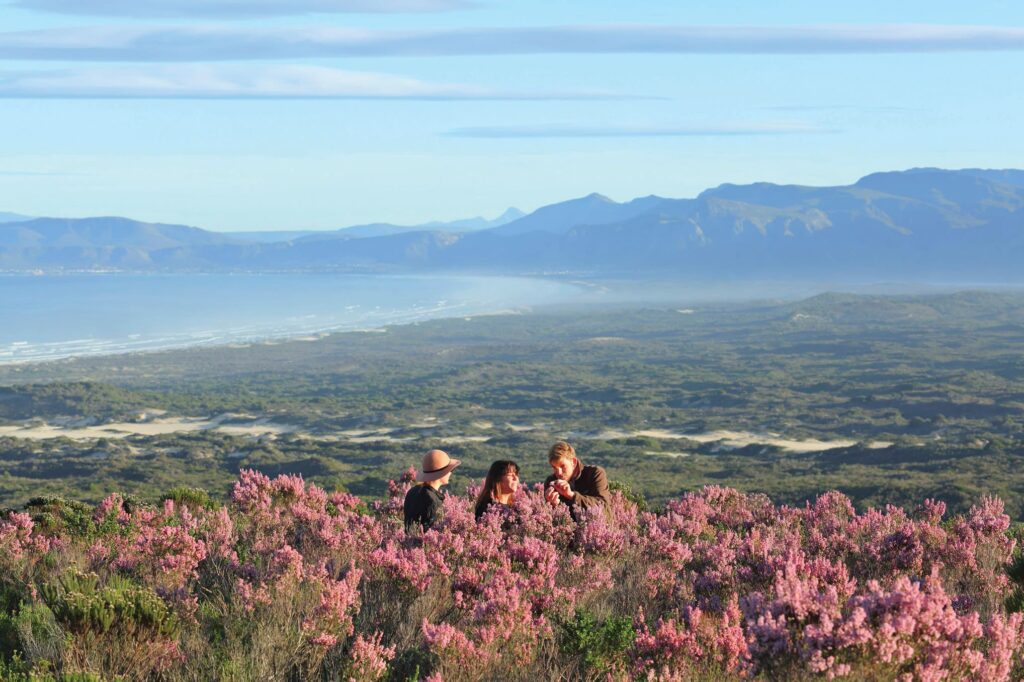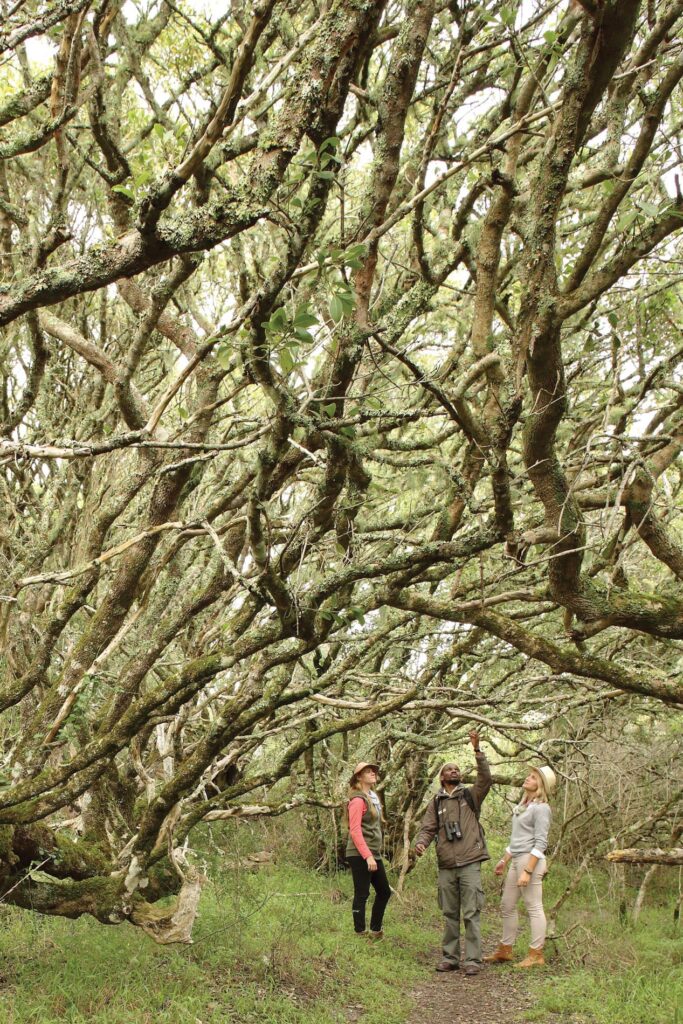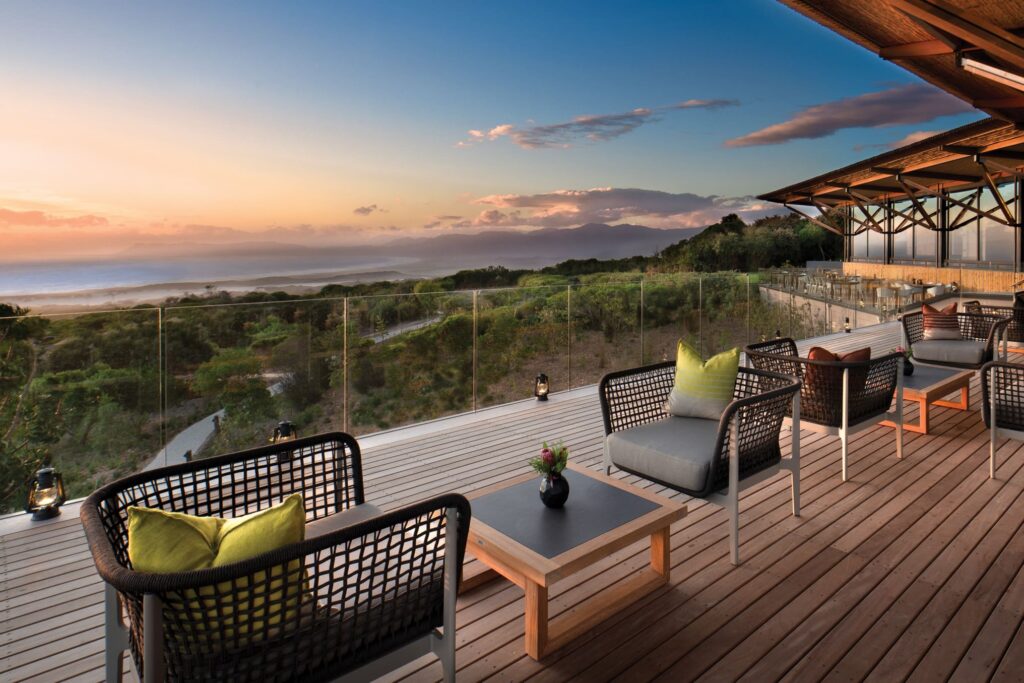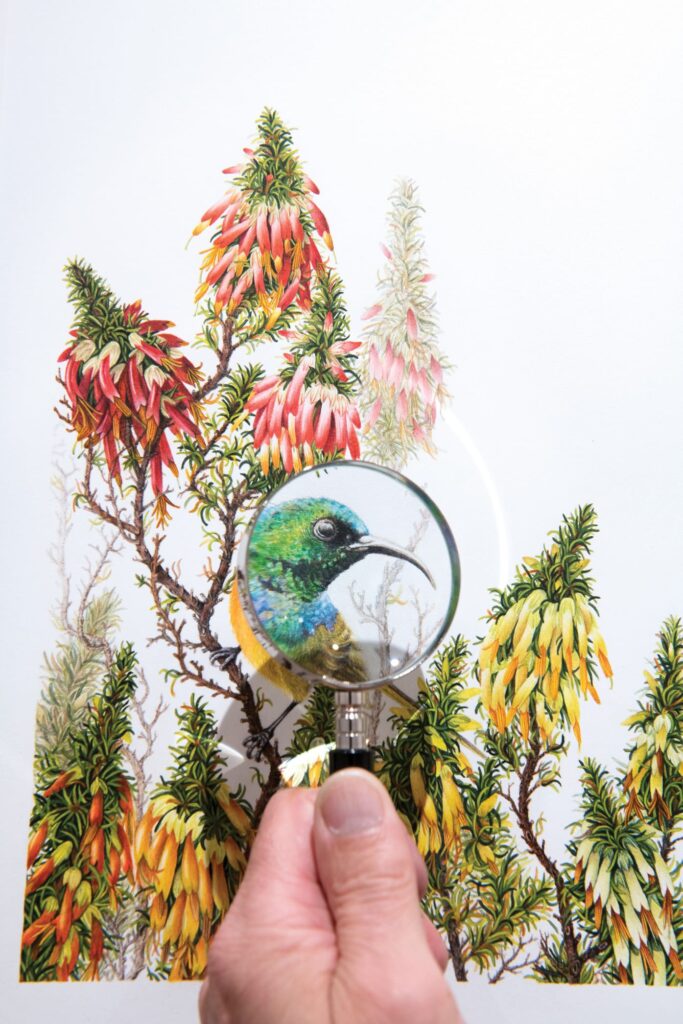In the heart of South Africa’s Overberg region, near the southernmost tip of the continent, tucked between mountains, forest, and sea, lies Grootbos Private Nature Reserve. Home to a unique botanical safari, the marine Big Five, farm-to-fork cuisine, limitless views of the Atlantic coastline, and one of the smallest and most diverse plant kingdoms on Earth, Alicia-Rae Light takes you on a journey where the flowers wait.

Exploring South Africa’s Overberg in the Grootbos Private Nature Reserve offers an opportunity to get up close with the flora on a unique botanical safari. All images courtesy of Grootbos.
There it is!” my naturalist guide, Tiaan van Dyk, enthusiastically shouts from the Land
Cruiser on a chilly fall afternoon. Winding through the flourishing green bush of Grootbos Private Nature Reserve overlooking the Atlantic, he proclaims, “An Erica irregularis—a plant species that only grows here on the property, the ones that surround us, and nowhere else in the world.” He abruptly stops the 4×4, jumps out of the vehicle, and runs towards the bushes—more precisely towards the fynbos (Afrikaans for ‘fine bush’)—a distinctive plant biome known as the Cape Floral Kingdom found only on the southern tip of Africa.
There are roughly 9,800 species of fynbos within the Cape Floral Kingdom, which covers around 34,749 square miles, of which two-thirds are endemic to the biome. Grootbos Private Nature Reserve cradles roughly 80 per cent of the world’s population of the rare Erica irregularis. The remaining 20 per cent is scattered on the coastal belt. Between May and July—considered secret season—its small green buds burst into a sea of tiny blush-pink blooms. It’s one of seven species previously unknown to science discovered here.
Overall, the reserve is home to 940 plant species, with new ones found frequently after controlled burns, by visiting researchers, and by field guides who are the eyes and ears on the ground. In the summertime, the area is covered in king and pin cushion protea, but right now, it’s all about the Ericas.
A New Kind of Safari: Encounters with Grootbos’ Flora and Fauna

Grootbos derived its name from our Milkwood forest, the “Groot bos”, which means the big thicket. It is one of only 10 Milkwood forests of its kind on earth.
At Grootbos, I’m welcomed with an immersive botanical safari, searching for flowers, not wildlife. “People tend to come to South Africa to see the Big Five, but what about the flora?” Tiaan posits. “You’re in an environment where you don’t have to rush off in a specific direction to go look at a lion kill, but you still get to go out into nature,” says Tiaan. “The flowers wait for you. They’ve been around for over five million years.”
“I like calling it the ‘intro to safari’ because you go out in the safari vehicle, but the plants don’t run; they stay where you leave them. You don’t always expect plants to be interesting, but once you’re out there, you learn about the pollinators, medicinal uses, and all the things that make plants amazing.”
Over the next hour, I experience the essence of a Grootbos safari. I learn about the banana shrimp Erica, (Heather Erica coccinea), which is sunbird-pollinated (and, yes, it looks like shellfish), and the Leonotis Leonurus, used as an anti-anxiety tea which, when you drink it, actually relaxes your shoulders and reduces the tension within the muscles. I sniff buchu—a spicy mix of rosemary and peppermint—another anti-inflammatory and antiseptic plant that’s delicious as tea. I hold the whimsical yellow blooms of Bietou bush, an immune booster. I’m in awe of the pretty little blooms of Zaluzianskya capensis, which, by day, has petals that remain tightly curled but, by evening, unfurl into scented star-shaped white flowers with deep burgundy on their backsides. All the while, I’m in a Land Cruiser with a cozy blanket, sipping on Grootbos’ fynbos-infused gin made with our favorite Erica, as well as other medicinal varietals, including Buchu, juniper, and angelica root. It’s herbal, peppery, and sweet.
Although not the focus, mammals also call the property home. Tiaan’s background as a mammalogist is what brought him to Grootbos, setting up conservation camera traps to track their movements. Caracal, honey badger, mongoose, porcupine, baboon, and antelope—including steenbok and bushbuck—are all here, albeit mostly nocturnal and out of sight. They’ve even identified more than four individual Cape leopards with the camera traps.
Luxurious Accommodations Amidst Nature’s Splendor

The patio and lounge area at the Forest Lodge has unparalleled views over the ocean of Walker Bay.
Grootbos (pronounced “Hroot-boss”) was once a simple farmhouse, bought in 1991 as a weekend getaway for the owner, Michael Lutzeyer, and his family, who fell in love with the area. They eventually built a few self-catering cottages for visitors passing through. In 2004, the Cape Floral Kingdom was declared a UNESCO World Heritage Site, with Grootbos helping protect 13.5 square miles of this pristine fynbos. Today, the property is one of South Africa’s finest lodges and has three accommodation styles designed in harmony with the environment: suites in the vibrant and cozy garden lodge, the sophisticated and serene forest lodge—each gathered around a central pool and restaurant—and two exclusive, fully staffed private villas.
From the bathtub in my villa, I have sweeping views of Walker Bay. Though low clouds have settled in, I can still make out the Cape Point lighthouse in the distance through the floor-to-ceiling sliding windows, which I’ve opened to hear the Atlantic Ocean crashing along the shoreline. The rose-scented geranium bath salts and the “tussy mussy” (a little bouquet of botanicals collected on safari) Tiaan handed me earlier have transformed my tub into a calming cauldron of relaxation. At the right time of year, you can even spot southern right whales from the bath. Grootbos offers not just luxury but an immersion into the biodiversity that surrounds it.
Later, I set off exploring from another vantage point: horseback. Rain is a rescue horse from a local farm who loves munching on the fynbos while I take in views of the bay and the strong scent of botanicals in the crisp air. Grootbos stands out with its diversity of activities—trails through ancient milkwood forests passing waterfalls, mountain biking, prehistoric cave visits, and guided walks in the forest with ecotherapist Grant Hine of ZenGuiding.
The Marine Big Five Safari, in partnership with Marine Dynamics, adds an oceanic dimension to the experience. With biologists on board, you set sail in search of shark, whale, dolphin, Cape fur seal, and African penguin. There is a possibility of seeing three different species of shark (great white shark, seven gill shark, and copper shark), three different species of whale (southern right whale, humpback whale, and Bryde’s whale), and three different species of dolphin (the common dolphin, humpback dolphin, and bottlenose dolphin).
Commitment to Sustainability and Community: The Grootbos Foundation

Our guide Tiaan van Dyk walking us through the conservation initiatives by the Grootbos Foundation.
Conservation of community and biodiversity is at the heart of the Grootbos experience. “Sustainable tourism is about integrating everything and getting the community involved. If you’re not doing tourism sustainably, then you’re only doing it for yourself,” says Tiaan.
“Sustainability brings the whole community together, and that’s what’s important—and that’s why we have the Grootbos Foundation. It’s about integrating everything—community, commerce, culture, and conservation.”
The Grootbos Foundation, active for two decades, extends its impact to education (including hospitality and gardening training programs), sports initiatives (including the Shewana program empowering young women to swim and surf), and partnerships for early childhood development.
There’s also an on-site nursery with endemic plants for purchase. The distinctive Erica irregularis honey, various teas, essential oils, and self-care products for sale create employment and bring money directly back into the community. The lodge employs people from the local community first before reaching out further.
Their list of sustainable initiatives is extensive too. The property is carbon negative; they use solar power, recycle their gray water, plant trees, manage all their own gardens, and produce some products and food on-site or from a supplier within 60 miles.
Culinary Delights and Conservation Efforts: The Grootbos Experience

Dining at Grootbos is an experience in its own right, with its unique combination of fresh organic produce, a world-class natural setting and our hugely experienced culinary team.
On my last morning, I happened to have breakfast next to Hannarie Wenhold—a guest turned investor who now has an onsite gallery as her namesake: the Grootbos Florilegium, also known as The Hannarie Wenhold Botanical Art Gallery. Commissioning the world’s best botanical artists, Grootbos channels proceeds into conservation efforts, supporting education and cultural preservation. The gallery, a fusion of art and conservation, adds a cultural dimension to the Grootbos experience. Stop in to view the magnificent artworks—the perfect place to spend a rainy afternoon admiring the intricate depictions of flowers, pollinators, and wildlife—magnifying glass in hand to see the finer details.
For lunch, I take one last tour of Chef Almie Leimecke’s menu, imbibing her mastery of transforming local bounty into culinary experiences that allow guests to taste the freshness and wildness of this unique place while connecting with each other. For larger groups, a fynbos- inspired tasting menu can be requested, as can a mindful eating experience with a silent picnic in the milkwood forest. Even the water, naturally filtered and bottled on-site reflects Grootbos’ dedication to sustainable practices.
Reflections on Nature’s Impact: The Essence of Grootbos

The Grootbos Florilegium is a tribute to the Cape Floral Kingdom’s diverse beauty through botanical art.
As my third day concludes, Tiaan reflects on Grootbos’ essence. “It’s about how the seasons change and the intricacies of how the flowers are designed to be pollinated by insects and birds. It’s a safari of the senses. You’re being handed plants, and you get to smell them, feel them, see them, and even taste them,” he says. “It’s about being out on the reserve and just stopping, listening to the birds, listening to the plants, and being aware of their processes because we run through life so fast that you don’t think about them.”
“We can’t hear it, but if you spend enough time in the forest, your body will start resonating at the same vibration as these trees, which creates a calming effect. Everything contains energy. Everything vibrates at a certain level,” says Tiaan. “If you spend time with someone who is happy and uplifting, you become happy and uplifting because your body is resonating at the same level of vibration.”
“Trees actually do that—they all kind of hum at the same beat, and that’s just unbelievable. You can’t hear it necessarily, but being here, you can feel your body becoming more relaxed. Humans have a tendency to put up walls or barriers. When the barrier goes down in a place like this, it’s easy to feel the forest around you.”
Plan your Trip
Ready to start planning your own incredible adventure? We make the process stress-free and enjoyable.
